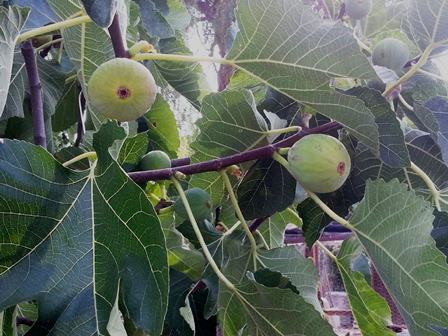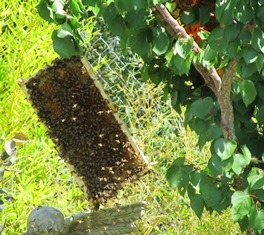Growing and Sharing Farmette Figs
It’s that time of year when our fig trees reward us with a second crop of sweet, juicy fruit, best eaten right from the tree.
We aren’t the only ones who love to eat figs. The birds and raccoons are leaving telltale marks that they’re helping us devour this sweet fruit. And it’s no wonder.
Figs are a nutrient-rich food with antioxidant properties. They contain magnesium, vitamin B6, fiber, and beneficial amounts of calcium and iron.
We grow a couple of varieties of figs on the farmette–a White Genoa and Brown Turkey. Our neighbors also have towering fig tree with a canopy that reaches over the neighbor’s house. The tree is loaded now with baseball-size, dark purple fruit. I believe it’s a Black Mission fig, introduced into California by Father Junipero Serra who planted them in 1769 at the San Diego mission.
Our Brown Turkey fig produces a crop twice each year. The first crop, known as the breba grows on last season’s wood. The second, and more abundant crop, grows on new wood.The fig has rose-colored flesh inside a brownish-purple skin that tends to crack open with the fig is overripe.
The White Genoa is self-fruitful and has yellow-green skin with strawberry-colored pulp. The taste is mild and sweet and can be enjoyed as fresh fruit or paired with tangy goat cheese. The tree bears two crops each year and benefits from a vigorous pruning in the autumn after the figs are harvested.
Both figs will lose their leaves, leaving only their bark color and scaffolding as winter interest in the garden. The White Genoa’s bark is light gray whereas the Brown Turkey has a darker shade of grayish-brown bark.
These trees can be grown in containers and kept to about six feet tall for people who don’t have a lot of space for a tree that can otherwise reach 15 to 20 feet.
Figs aren’t fussy about soil, but won’t tolerate excessive water. They like the sun and are pretty hardy here in Northern California. Many figs are self-fruitful, but keeping bees means I have pollinators to help the fig crops along.
Urban Farms Make Sense for Lots of Reasons
Reduce city blight. Give city residents the opportunity to farm. Grow food for low-rent residents. Eliminate illegal dumping. Create public gardens on private land until the owner decides on another use. Lower property taxes for land owners. Improve the local environment. These are just a few reasons urban farms make a lot of sense and should be promoted.
As it turns out, the city of San Francisco is leading the way. The city has a new law offering financial incentives in the form of reduced property taxes for owners of empty lots who permit agricultural use of their land for at least five years or more.
Part of the statewide Urban Agriculture Incentive Zones Act, the law encourages potential urban farmers to convert weedy, empty lots or those covered in trash into gardens. These urban farmers necessarily would have to put in resources such as labor and money but the law ensures they cannot be forced out of their contracts, thus losing their investment.
The law is the brainchild of sustainable land-use advocates and state Assemblyman Phil Ting, D-San Francisco. Cities must first pass the necessary local ordinance and San Francisco has already done that.
Urban farmers must comply with local ordinances with regard to keeping bees and farm animals. But the idea of urban gardens reducing blight (which may also be prone to illegal dumping) has wide appeal for cities eager to stabilize property values and also provide more green spaces.
While other cities in California explore the environmental benefits of urban farms (including Fresno, Los Angeles, Sacramento, San Diego, and San San Jose), San Francisco leads the way.
A city lot must meet certain qualifications: it has to be at least one-tenth of an acre. Additionally, there must be no permanent buildings on the lot. Qualified lots are re-assessed with a significantly lower tax bill for its owner.The new tax assessment is based on the average rate of irrigated farmland.
The idea of more urban farms means a win for the city, local residents, the land owners, and the environment.
 Facebook
Facebook Goodreads
Goodreads LinkedIn
LinkedIn Meera Lester
Meera Lester Twitter
Twitter





